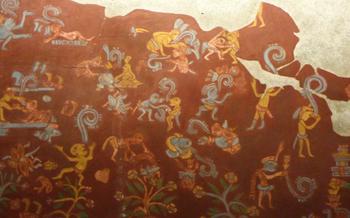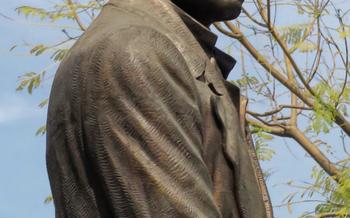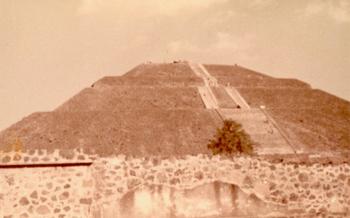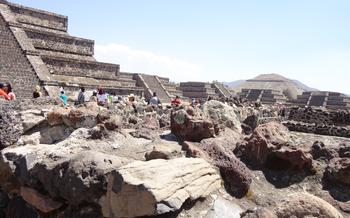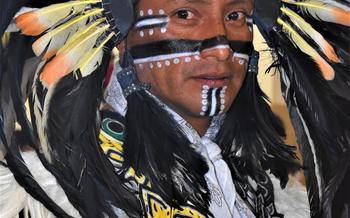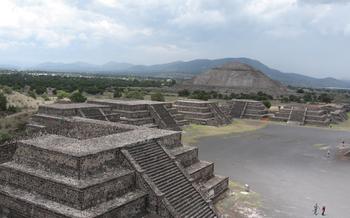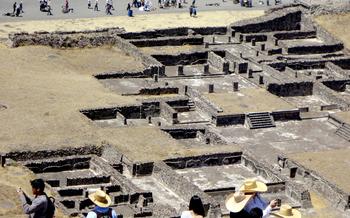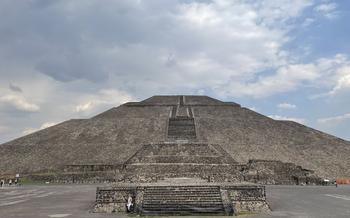
Pyramid of the Moon
- The Pyramid of the Moon in Teotihuacan: A Journey Through Time
- Exploring the Pyramid: A Step-by-Step Guide
- The Avenue of the Dead: A Path of Discovery
- The Temple of Quetzalcoatl: Unveiling Ancient Mysteries
- The Palace of Quetzalcoatl: A Glimpse into Royal Life
- The Great Compound: A Center of Activity
- The Museum of Teotihuacan: Unveiling Hidden Treasures
- A Walk Through History: Exploring Other Pyramids
- Tips for Navigating the Site: A Visitor's Guide
- Unveiling the Mysteries: A Look at Teotihuacan's History
- Legends and Myths: The Enchantment of Teotihuacan
- A Unique Souvenir: The Magic of Teotihuacan Crafts
- Insider Tip: The Best Time to Visit
The Pyramid of the Moon in Teotihuacan: A Journey Through Time
In the heart of Mexico, nestled within the ancient city of Teotihuacan, lies the majestic Pyramid of the Moon, a testament to the ingenuity and architectural prowess of a civilization that thrived centuries ago. This colossal pyramid stands as the second largest structure in Teotihuacan, after the renowned Pyramid of the Sun, captivating visitors with its grandeur and historical significance.
The Pyramid of the Moon was constructed during the Classic period of Teotihuacan's existence, approximately between the 1st and 7th centuries AD. It served as a significant religious and ceremonial center, where ancient rituals and offerings were performed to honor the deities and seek their blessings. The pyramid's alignment with the moon and its prominent position in the city's layout suggest its deep connection to celestial events and the lunar cycles.
When exploring the Pyramid of the Moon, visitors are greeted by its imposing facade and the expansive plaza that extends before it. The pyramid's stepped structure invites visitors to ascend its steep slopes, leading them to the summit, where breathtaking panoramic views of the entire archaeological site await. The pyramid's intricate carvings and decorative elements, though weathered by time, hint at the artistic mastery and symbolism that once adorned its surfaces.
As you stand atop the Pyramid of the Moon, allow your imagination to transport you back in time, to an era when Teotihuacan pulsed with life, and this pyramid stood as a beacon of spirituality and power. Feel the connection to the ancient civilization that built this architectural marvel and marvel at the legacy they left behind for us to discover and cherish.
Exploring the Pyramid: A Step-by-Step Guide
The Pyramid of the Moon, the second largest pyramid in Teotihuacan, invites you on a journey through time. As you approach the pyramid, its imposing size and intricate carvings will immediately captivate you. Begin your exploration by climbing the grand staircase that leads to the top. Take your time, as the climb offers breathtaking views of the surrounding landscape.
Once you reach the summit, you will be rewarded with panoramic vistas of the entire archaeological site, including the Avenue of the Dead, the Sun Pyramid, and the Temple of Quetzalcoatl. Allow yourself to be transported back in time as you imagine the ancient city bustling with life and activity.
To fully appreciate the pyramid's grandeur, walk around its perimeter. Admire the intricate carvings and sculptures that adorn the facade, each telling a story about the beliefs and rituals of the Teotihuacan people. Don't forget to explore the tunnels and chambers within the pyramid, which offer a glimpse into the engineering prowess of the ancient builders.
As you navigate the pyramid, be mindful of the crowds. Avoid peak tourist hours to ensure a more peaceful experience. If possible, visit the pyramid early in the morning or late in the afternoon when the light casts long shadows, creating a magical ambiance.
The Avenue of the Dead: A Path of Discovery
The Avenue of the Dead, stretching over 2 kilometers in the heart of Teotihuacan, serves as a grand promenade connecting the city's most significant structures. This iconic thoroughfare holds immense cultural and historical significance, inviting visitors to embark on a journey through time and uncover the secrets of this ancient civilization. Along its path, the Avenue of the Dead boasts impressive landmarks, including the majestic Sun Pyramid, which stands as a testament to the architectural prowess of the Teotihuacan people.
Strolling down the Avenue, visitors are transported back in time, imagining the bustling streets filled with merchants, pilgrims, and nobles. The intricate carvings and colorful murals adorning the surrounding buildings offer glimpses into the daily lives, beliefs, and rituals of the ancient Teotihuacans. As you approach the Sun Pyramid, the sheer scale and grandeur of this colossal structure inspire awe and wonder, leaving you humbled by the ingenuity of its creators.
Beyond the Sun Pyramid, the Avenue of the Dead continues, leading to the Temple of Quetzalcoatl and the Palace of Quetzalcoatl. Each structure along this path holds its unique significance, contributing to the rich tapestry of Teotihuacan's cultural and historical heritage. Take your time to explore these landmarks, marveling at the intricate details and the stories they hold. The Avenue of the Dead is not just a path but a gateway to understanding the grandeur and complexity of this ancient civilization.
The Temple of Quetzalcoatl: Unveiling Ancient Mysteries
Among the many wonders of Teotihuacan, the Temple of Quetzalcoatl stands as a testament to the city's intricate religious beliefs and artistic prowess. Dedicated to the Feathered Serpent deity, this temple showcases remarkable architectural features and symbolism that offer a glimpse into the spiritual world of the ancient Teotihuacanos.
The temple's design is a masterpiece of symmetry and precision. Its iconic facade is adorned with intricate carvings depicting the feathered serpent, along with other symbols and figures from Teotihuacan's mythology. The temple's interior features a series of chambers and altars, each adorned with vibrant murals and sculptures that tell stories of creation, sacrifice, and the afterlife.
The Feathered Serpent, known as Quetzalcoatl, was a central figure in Teotihuacan's religious beliefs. Depicted as a majestic serpent covered in feathers, Quetzalcoatl was associated with wind, rain, and fertility. He was believed to be the creator of humanity and the bringer of knowledge and culture to the people of Teotihuacan.
Exploring the Temple of Quetzalcoatl is a journey into the heart of ancient Teotihuacan's spiritual world. The temple's architecture, symbolism, and iconography provide valuable insights into the beliefs and rituals of this fascinating civilization.
The Palace of Quetzalcoatl: A Glimpse into Royal Life
Hidden amidst the ancient ruins of Teotihuacan lies the Palace of Quetzalcoatl, a testament to the grandeur and splendor of the city's rulers. As you approach the palace, the intricate murals and sculptures adorning its facade will captivate your attention, hinting at the stories and secrets held within.
Once inside, you'll be transported back in time as you explore the palace's opulent chambers and courtyards. Marvel at the vibrant murals depicting scenes from Teotihuacan's history, showcasing the city's cultural and religious beliefs. Each brushstroke tells a tale of power, devotion, and the divine.
The palace was not merely a residence for the city's rulers but also a center of political and religious authority. Within these walls, important decisions were made, ceremonies were held, and the fate of the city was shaped. Imagine the footsteps of ancient rulers echoing through the corridors as they navigated the intricate political landscape of Teotihuacan.
As you wander through the palace's rooms, you'll discover hidden alcoves and secret passageways, each revealing a glimpse into the private lives of the city's elite. Admire the intricate carvings and sculptures that adorn the walls, each one a masterpiece of ancient craftsmanship.
The Palace of Quetzalcoatl is a testament to the sophistication and artistry of Teotihuacan's civilization. It invites you to step into the shoes of royalty and experience the grandeur and opulence of ancient Mexican rulers.
The Great Compound: A Center of Activity
At the heart of Teotihuacan lies the Great Compound, a sprawling complex that served as the city's administrative and ceremonial center. Encompassing an area of over 1 square kilometer, this impressive site showcases the engineering prowess and urban planning of the ancient Teotihuacanos.
The Great Compound consists of a series of plazas, temples, and residential areas arranged around a central axis. The main plaza, known as the Plaza of the Sun, is surrounded by several smaller plazas, including the Plaza of the Moon and the Plaza of the Feathered Serpent. Each plaza was likely used for different rituals and ceremonies, reflecting the diverse religious beliefs of the Teotihuacanos.
Within the compound, visitors can explore various temples, including the Temple of Quetzalcoatl and the Temple of the Feathered Serpent. These temples were dedicated to specific deities and were adorned with elaborate murals and sculptures, providing valuable insights into the beliefs and practices of the ancient city's inhabitants.
Residential areas within the compound offer a glimpse into the daily lives of the Teotihuacanos. Excavations have revealed well-preserved houses, workshops, and storage facilities, providing evidence of a complex and organized society.
As you wander through the Great Compound, imagine the bustling activity that once filled this space. Merchants hawking their wares, priests performing sacred rituals, and rulers holding court—the Great Compound was a vibrant hub of commerce, religion, and politics, a testament to the power and influence of ancient Teotihuacan.
The Museum of Teotihuacan: Unveiling Hidden Treasures
Enrich your visit to the Pyramid of the Moon with a profound journey into the past at the Museum of Teotihuacan. This world-renowned museum serves as a gateway to the captivating history and cultural heritage of this ancient city. Within its walls, you'll embark on an immersive exploration of Teotihuacan's intricate past, unraveling the mysteries that have captivated historians and archaeologists for centuries.
Discover an extensive collection of artifacts, carefully curated and showcased to provide a glimpse into the daily lives, beliefs, and rituals of the Teotihuacan people. Marvel at intricately carved stone sculptures, delicate pottery, and obsidian tools, each piece narrating a chapter in the city's rich history.
Interactive exhibits and educational displays further enhance your experience, bringing the ancient civilization to life. Engage with multimedia presentations, touchscreens, and hands-on activities that illuminate the profound cultural and religious significance of Teotihuacan.
The museum's mission extends beyond mere exhibition; it actively participates in the preservation and conservation of Teotihuacan's legacy. Through ongoing research, restoration projects, and educational initiatives, the museum plays a pivotal role in ensuring that the wonders of this ancient metropolis continue to inspire and captivate generations to come.
Pro Tip: For an in-depth understanding of Teotihuacan's history and culture, consider booking a guided tour of the museum. Knowledgeable guides will provide expert insights and anecdotes, enriching your exploration of this fascinating institution.
A Walk Through History: Exploring Other Pyramids
While the Pyramid of the Moon and the Sun Pyramid are undoubtedly the most famous structures in Teotihuacan, there are numerous other pyramids scattered throughout the site. Though smaller in size, these lesser-known pyramids offer unique insights into the city's past and showcase the diverse architectural styles that existed during Teotihuacan's heyday.
One of the most intriguing pyramids is the Pyramid of the Feathered Serpent, located near the Temple of Quetzalcoatl. This pyramid features intricate carvings depicting the Feathered Serpent deity, a central figure in Teotihuacan's mythology. The Pyramid of the Sun and Moon can be seen clearly from its summit, offering a breathtaking panorama of the entire archaeological site.
Another notable pyramid is the Pyramid of the Sun and Moon, located between the two main pyramids. It is believed to have been constructed as a tribute to both the sun god and the moon goddess. The pyramid's unique stepped design and elaborate carvings set it apart from the other structures in Teotihuacan.
To fully appreciate the diversity and grandeur of Teotihuacan's architecture, visitors should take the time to explore these lesser-known pyramids. By venturing beyond the main attractions, they can gain a deeper understanding of the city's rich history and cultural significance.
Tips for Navigating the Site: A Visitor's Guide
Proper Attire: When embarking on your journey to Teotihuacan, ensure you dress appropriately for the occasion. Comfortable and sturdy footwear is paramount, as you will be doing a lot of walking on uneven terrain. Opt for lightweight, breathable clothing that will keep you cool under the Mexican sun.
Hydration and Sun Protection: Mexico's climate can be unforgiving, so staying hydrated is crucial. Bring a reusable water bottle and replenish it regularly. Sunscreen is also essential to protect your skin from the intense UV rays. Apply it liberally and reapply throughout the day, especially if you have fair skin.
Safety Precautions: While Teotihuacan is generally safe for tourists, it's always wise to exercise caution. Be aware of your surroundings and keep an eye on your belongings. Avoid carrying large amounts of cash or valuables, and if you have any concerns, don't hesitate to ask for assistance from the site's security personnel.
Unveiling the Mysteries: A Look at Teotihuacan's History
The origins of Teotihuacan remain shrouded in mystery, with numerous theories and speculations attempting to unravel its enigmatic beginnings. One prevailing theory suggests that the city was founded around 100 BC by a group of nomadic tribes who migrated from the north. Another theory posits that Teotihuacan was established by indigenous peoples who had inhabited the region for centuries.
Despite these competing theories, it is widely believed that Teotihuacan reached its peak between the 1st and 7th centuries AD, during which time it became one of the largest and most influential cities in the pre-Columbian Americas. During this period, Teotihuacan developed a complex social and political structure, with a ruling elite that oversaw the construction of monumental pyramids, temples, and palaces.
The city's decline began around the 7th century AD, and by the 9th century, it had been abandoned by its inhabitants. The reasons for this decline are still debated, with theories ranging from environmental factors such as drought to internal political conflicts.
Unveiling the history of Teotihuacan is an ongoing process, and archaeologists continue to uncover new insights into this ancient civilization. By studying the city's ruins, artifacts, and inscriptions, researchers are piecing together the story of a once-great metropolis that played a pivotal role in the development of Mesoamerican culture.
Legends and Myths: The Enchantment of Teotihuacan
Teotihuacan is not just a collection of ancient structures; it's a place where legends and myths intertwine, creating a captivating aura of mystery and enchantment. One of the most prominent legends tells the story of the construction of the pyramids, which is said to have been accomplished by divine intervention. According to the myth, the gods descended to Earth and used their supernatural powers to build the pyramids in a single night.
Other myths and legends revolve around the gods and goddesses associated with Teotihuacan. Quetzalcoatl, the Feathered Serpent, is a prominent figure in these stories, often depicted as a wise and benevolent deity who brought knowledge and culture to the ancient city. Tlaloc, the god of rain, is another important figure, revered for his power to bring life-giving water to the arid lands.
These legends and myths were not just mere tales; they were integral to the cultural and religious beliefs of the ancient Teotihuacans. They shaped their understanding of the world, their place in it, and their relationship with the divine. Even today, these stories continue to captivate visitors, adding a layer of magic and wonder to the already awe-inspiring ruins of Teotihuacan.
A Unique Souvenir: The Magic of Teotihuacan Crafts
Teotihuacan is not just a place of ancient ruins but also a vibrant hub of artistry and craftsmanship. Visitors can immerse themselves in the local culture by exploring the colorful markets and shops surrounding the archaeological site. These markets are a treasure trove of handmade crafts and souvenirs, each piece infused with the spirit and symbolism of Teotihuacan's rich history.
From intricately carved obsidian figurines to vibrant ceramic pottery, there is something to suit every taste and budget. Bargaining is expected and part of the experience, so don't be afraid to negotiate a fair price. By purchasing these locally made souvenirs, you not only take home a piece of Teotihuacan but also support the talented artisans who keep these traditions alive.
One of the most popular crafts is the alebrije, a fantastical creature made from papier-mâché and painted in vibrant colors. These whimsical creations represent mythical and real-world animals, each with its unique personality. Another must-have souvenir is the obsidian mirror, believed to have protective and mystical powers. These mirrors are meticulously carved and polished, reflecting the ancient obsidian workshops that once thrived in Teotihuacan.
For those looking for a touch of elegance, the silver jewelry crafted by local artisans is a must-see. Intricate designs inspired by Teotihuacan's iconography adorn necklaces, bracelets, and earrings, making for a stylish and meaningful memento.
When shopping for souvenirs in Teotihuacan, remember to be respectful of the artisans and their work. Ask permission before taking photos and always negotiate prices politely. By supporting local crafts, you contribute to preserving the cultural heritage of this ancient city and ensuring that its traditions continue to thrive for generations to come.
Insider Tip: The Best Time to Visit
To fully appreciate the grandeur and tranquility of the Pyramid of the Moon and the entire Teotihuacan site, it's crucial to choose the right time for your visit. Avoid the peak tourist season, which typically falls between December and March, when crowds can be overwhelming and detract from the experience.
Instead, aim for the shoulder months of April, May, September, and October. During this time, the weather is still pleasant, but the crowds are significantly smaller, allowing you to explore the site at a more leisurely pace. You'll have the opportunity to soak in the atmosphere, take captivating photos, and engage with local guides without feeling rushed.
If you're particularly interested in learning more about Teotihuacan's rich history and culture, plan your visit to coincide with one of the special events or cultural festivals held throughout the year. These events often feature traditional dances, music, and reenactments, providing a glimpse into the vibrant world of this ancient civilization.
With a little planning and flexibility, you can ensure that your visit to the Pyramid of the Moon and the archaeological site of Teotihuacan is both enjoyable and enriching.


